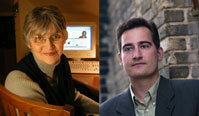 |
→ April 2005 Contents → Column
|
Actually, There Is No Line...
|
 |
|
Consider the following two incidents involving photojournalists.
In February, a photojournalism student from San Francisco State University was arrested and charged with two misdemeanors after photographing five other students breaking into a parked car and stealing cash and CDs. The student defended his decision to photograph the incident rather than reporting the incident to police on the grounds that he was acting as a journalist. (see SF State Student Arrested on Burglary Charges.) The April edition of NPPA’s News Photographer reports that at least two of his professors defended the student’s actions.
Last year, a crew from KWCH was doing a live shot at an intersection noted for accidents. During the remote, a truck and car collided. The reporter kept talking and the photographer continued to shoot the scene. Neither put down the microphone or the camera to offer assistance to the crash victims. (see http://nod.se/sandbox/2004-09-27/crashreport)
These kinds of stories raise the following question: Where do our obligations as professionals end and our obligations as humans begin? Rather than try to find that line, let’s step back a moment and rethink the question. This essay argues that there is no line between the moral responsibilities of the photojournalist as professional and the photojournalist as human being.
Here is why.
As professionals and as human beings, we have two sets of moral obligations. As humans, philosopher W. D. Ross tells us, we have prima facie (i.e., self-evident) duties that include telling the truth, keeping promises, being just, doing good, being loyal, avoiding harm and repairing harm. These duties can come into conflict and our task as a moral agent is to determine which duty takes priority in a given situation.
At the same time, professionals are members of smaller groups -- each of which has obligations that are spelled out in its code of ethics. Typically, the group’s ethical code is grounded in the purpose of the profession. For instance, the physician’s code of ethics centers on repairing harm to the body. The lawyer’s code of ethics focuses on the notion of furthering justice. The journalist’s code of ethics focuses on truth-telling.
Often, these codes of ethics are simply more particular instances of the general obligations we all have as human beings. For example, the NPPA Code of Ethics says visual journalists should be “accurate,” “comprehensive,” and “complete in their story telling.” They should do nothing that would call their story-telling integrity into question, including paying sources or accepting gifts or money. Photojournalists are told to refrain from manipulating photographs or reality. These practices are discouraged because they introduce the potential for bias or deception, and move the photojournalist’s story away from the truth, and the photojournalist away from truth-telling. Photojournalists are also discouraged from “stereotyping” others or invading privacy. These are specific types of harm that can occur when gathering and reporting stories. (See the NPPA Code of Ethics.)
Professional codes are never complete, and when they do not cover specific situations, we can appeal to our more general obligations for guidance. Revisiting our cases with this in mind, it is evident that the photojournalist’s code of ethics does not cover whether to report a crime-in-progress, but the general obligation of justice suggests that the photojournalist should. The code does not suggest offering aid to the injured, but the general moral obligation to repair harm certainly points the photojournalist in that direction. Relevant human obligations as well as relevant professional obligations must be factored into the moral decision-making process, even when it is done on the fly.
It follows, then, that a simple appeal to professional obligations might not serve as a justification in either of the above-mentioned cases. In fact, moral reasoning suggests that general human obligations in both cases outweigh the photojournalist’s professional obligations. Honoring one’s human obligations would not likely damage story-telling ability or journalistic credibility in either instance. Further, both the larger society as well as the individual victims of the robbery and the crash would stand to benefit.
That is not to say that the more general human obligations will take precedence in all cases. Certainly, the context and facts of an incident play an important role in determining which principles to apply. If, for example, a photojournalist is on the scene of an accident where paramedics are nearby, his or her aid will not be necessary and it is appropriate to continue shooting and reporting. And there are times when it is more important to document a crime-in-progress for the public’s attention than it is to notify the police. Capturing police brutality as it unfolds comes to mind.
The point is: There is no clear line between professional and general moral responsibilities. There is only tension between moral principles, both general and professional. The photojournalist must decide which moral principles are in play in a given situation and which should be paramount. Is it the more general obligation that one has as a human? Is it the obligation that is particular to the profession?
This decision-making process requires both skill and moral imagination. Clearly there is more to journalism than truth-telling and there is more to being human than acting “professional.” Understanding the relationship between the human and the professional moral obligations allows us to reframe our initial question about where to draw the line. Instead of asking the either-or question, we might ask ourselves “Which moral choice best reflects our commitment to being both professional and human?”
© Karen Slattery and Erik Ugland
|
|
Back to April 2005 Contents
|
|